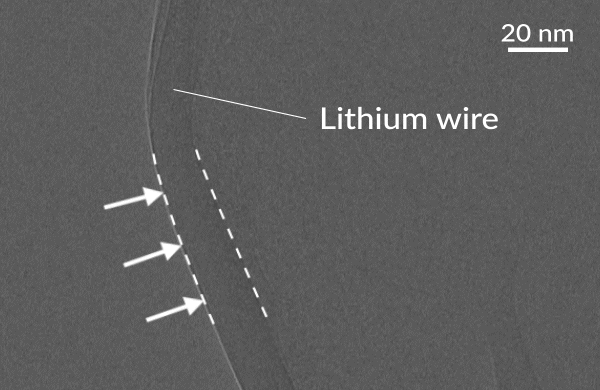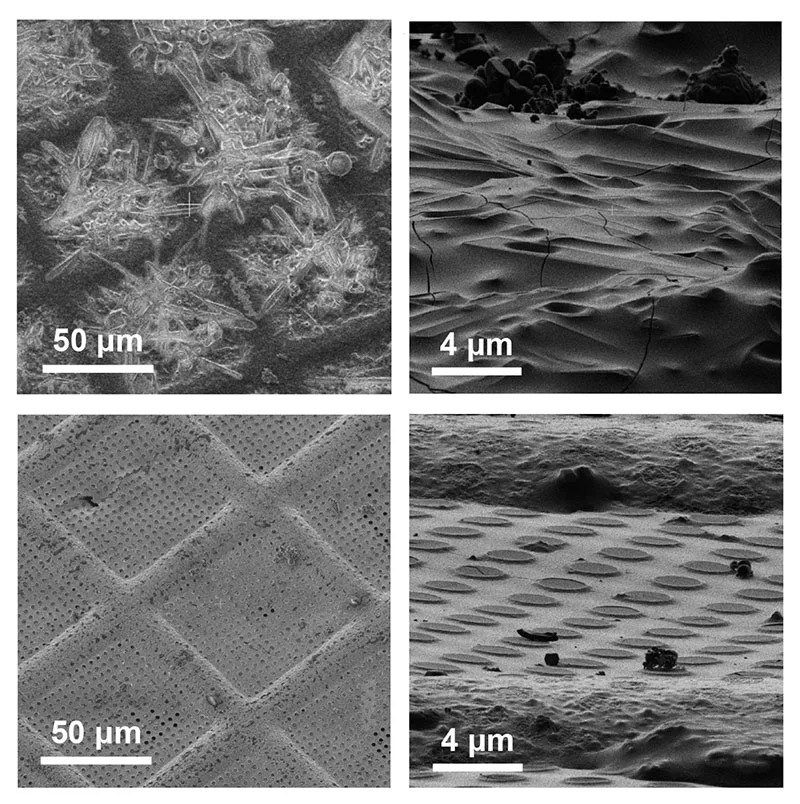创新背景
锂金属电池在给定空间内可以比现在的锂离子电池储存更多的电量,为下一代电动汽车、电子产品和其他用途开发锂金属电池的竞赛正在展开。
但其中一个障碍是电池的两个部分之间的无声斗争。电池电极之间的液体,即电解液,会腐蚀锂金属阳极的表面,在其表面覆盖一层称为固体电解液间相(SEI)的薄粘稠层。
尽管SEI的形成被认为是不可避免的,但研究人员希望稳定和控制这一层的增长,使电池的性能最大化,但他们没有好办法能清楚地知道SEI在电解液饱和时的样子。
创新过程
来自美国能源部SLAC国家加速器实验室和斯坦福大学的研究人员拍摄了第一张固体电解液间相(SEI)的高分辨率图像,显示了这一层天然饱满的状态。这一进展是由低温电子显微镜(冷冻电镜)实现的,这是一项革命性的技术,可以揭示原子一样小的细节。
低温电子显微镜是一种电子显微镜,它使用电子而不是光来观察非常微小的世界。通过将样本快速冷冻到透明的玻璃状状态,科学家们可以在自然状态和原子分辨率下观察执行生命功能的细胞机器。

该视频显示了一根锂金属线,上面涂有一层称为SEI的层,并与周围的液体电解质饱和;虚线表示此 SEI 图层的外边缘。当电解质被去除时,SEI变干并收缩(箭头)至其先前厚度的一半左右。
受到生物低温电子显微镜许多成功故事的启发,研究人员探索低温电子显微镜是否可以像研究生命系统一样,成为研究能源相关材料的有用工具。
他们首先关注的是电池电极上令人困扰的SEI层。2017年,他们发布了这一层的第一张原子尺度图像,还发布了锂丝像手指一样生长的图像,这些锂丝可以刺穿电池两半之间的隔膜,导致短路或起火。
但为了制作这些图像,他们必须将电池部件从电解质中取出,这样SEI就会干燥到收缩状态。任何人都不知道它在工作的电池中处于潮湿状态时是什么样子。
为了在潮湿的原生环境中捕获SEI,研究人员制作并冷冻极薄的电解质液体薄膜,其中含有微小的锂金属线,这为腐蚀和SEI的形成提供了表面。

在下一代锂金属电池中,电极之间的液体(称为电解质)腐蚀电极表面,形成称为SEI的薄而柔软的层。为了在其原生环境中制作该层的原子级图像,研究人员将金属网格插入工作纽扣电池(左)中。当他们将其移除时,电解质薄膜附着在网格内的微小圆形孔上,通过表面张力固定到位,并且SEI层已在这些孔中的微小锂导线上形成。研究人员在将网格浸入液氮(右)之前吸走了多余的液体(中心),将薄膜冷冻成玻璃状状态,以便用冷冻电镜检查。这产生了SEI层在其自然肿胀状态下的第一个详细图像。
首先,他们将用于保存低温电磁样本的金属网格插入硬币电池中。当他们把它取出来的时候,电解液薄膜附着在网格内的小圆孔上,在表面张力的作用下,薄膜被固定在那里,时间刚好足够完成剩下的步骤。
然而,这些薄膜仍然太厚,电子束无法穿透并产生清晰的图像。因此,研究人员提出了一个解决办法:用吸墨纸吸掉多余的液体。被吸干的网格立即被放入液氮中,将小薄膜冻成玻璃状,完美地保存了SEI。这一切都是在一个封闭的系统中进行的,该系统保护胶片不暴露在空气中。结果发现,在这些潮湿的环境中,SEI吸收电解液,膨胀到原来厚度的两倍左右。

电解质附着在样品网格上的孔上的冷冻电镜图像显示了为什么在冷冻和成像样品之前吸走多余的电解质很重要。在顶部,多余的电解质已经冻结成一层厚厚的(右),有时甚至形成晶体(左),阻挡了显微镜对下面微小圆形样品的观察。在吸墨(底部)后,可以清楚地看到网格(左)及其微小孔(右)并用电子束探测。
当研究小组对其他六种不同化学成分的电解质重复这一过程时,他们发现一些电解质产生的SEI层比其他电解质厚得多,而膨胀最严重的层与最差的电池性能有关。
研究小组还使用原子力显微镜(AFM)的超细尖端探测SEI层的表面,并证实它们在湿润、膨胀状态下比在干燥状态下更柔软。
自2017年的论文揭示了冷冻电镜对能源材料的作用以来,它被用于放大太阳能电池的材料,以及被称为金属有机框架的笼状分子,可用于燃料电池、催化和气体存储。
至于下一步,研究人员表示,他们希望找到一种方法来对这些材料进行3D成像,并在它们仍在工作电池内时对它们进行成像,以获得迄今为止最真实的图像。
创新关键点
研究人员制作并冷冻极薄的电解质液体薄膜,其中含有微小的锂金属线,这为腐蚀和SEI的形成提供了表面。
创新价值
研究结果表明,合适的电解液可以最小化膨胀,提高电池的性能——这为科学家提供了一种潜在的新方法来调整和改进电池设计。它们也为研究人员在日常工作环境中研究电池提供了一种新的工具。
Innovative development of "Cryo-EM snapshot" can improve battery design
Researchers from the U.S. Department of Energy's SLAC National Accelerator Laboratory and Stanford University have taken the first high-resolution images of the solid electrolyte interphase (SEI), showing the naturally plump state of this layer. The advance was made possible by cryo-electron microscopy, a revolutionary technique that reveals details as small as atoms.
Cryo-em is a type of electron microscope that uses electrons instead of light to see very small parts of the world. By rapidly freezing samples to a transparent glassy state, scientists can observe the cellular machines that perform life functions in their natural state and at atomic resolution.
Inspired by the many success stories of biological cryo-EM, researchers explored whether cryo-EM could be as useful a tool for studying energy-related materials as it is for studying living systems.
Their first focus was on the troublesome SEI layer on the battery electrodes. In 2017, they released the first atomic-scale image of this layer, as well as images of finger-like growth of lithium wires that can Pierce the diaphragm between the two halves of a battery, causing a short circuit or fire.
But to make those images, they had to remove the battery parts from the electrolyte, so that the SEI would dry to a shrunken state. No one knows what it looks like when it's wet in a working battery.
To capture SEI in their moist native environment, the researchers came up with a way to make and freeze extremely thin films of electrolyte liquid containing tiny lithium metal wires, which provide a surface for corrosion and SEI formation.
First, they inserted the metal mesh used to hold the cryogenic electromagnetic sample into the coin battery. When they took it out, the electrolyte film was attached to small circular holes inside the mesh, where it was held by surface tension just long enough to do the rest of the procedure.
However, these films are still too thick for the electron beam to penetrate and produce a clear image. So researchers have come up with a solution: use blotting paper to mop up excess liquid. The blotted mesh was immediately placed in liquid nitrogen, freezing the small film glassy and perfectly preserving the SEI. This is all done in a closed system that protects the film from exposure to air. It turns out that in these humid environments, sei absorbs the electrolyte and expands to about twice its original thickness.
When the team repeated the process for six other electrolytes with different chemical compositions, they found that some produced SEI layers that were much thicker than others, and that the most inflated layers were associated with the worst battery performance.
The team also used the ultrafine tip of an atomic force microscope (AFM) to probe the surface of the SEI layers and confirmed that they are softer in the wet, expanded state than in the dry state.
Since the 2017 paper revealed the role of cryEM on energy materials, it has been used to amplify materials for solar cells, as well as cage-like molecules called organometallic frameworks that can be used in fuel cells, catalysis and gas storage.
As for the next step, the researchers say they hope to find a way to image the materials in 3D and image them while they are still inside a working battery to get the most realistic picture yet.
智能推荐
储能科学创新思维 | 利用机器学习帮助提高锂离子电池和燃料电池的性能
2022-09-01帝国理工学院的研究人员将机器学习与能源储存相结合,开发出了一种名为“深度卷积生成对抗网络”(DC-GANs)的新技术。研究团队的发现将帮助能源领域的研究人员设计和制造优化电极,以提高电池性能。
涉及学科涉及领域研究方向废弃物能回收创新思维 | 新型化学工艺利用钴基催化剂可实现更高效的塑料回收
2022-10-10一种新的化学过程可以将各种塑料分解成可用的丙烷——这可能是解决无法有效回收多种塑料的一个办法。
涉及学科涉及领域研究方向